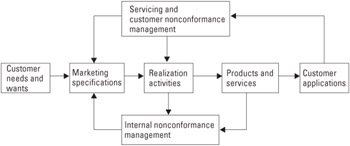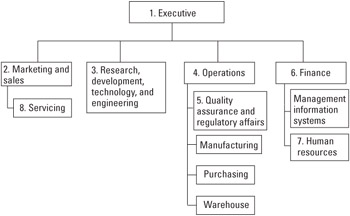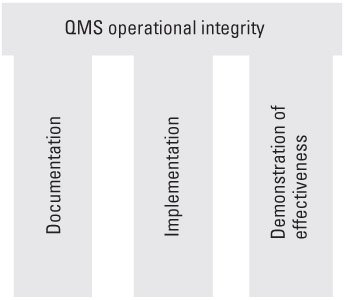1.2 Core Competencies
|
1.2 Core Competencies
The QMS requirements are superimposed upon the overall operational structure of the organization. You do not design the organization to follow a standard. Standards are used to enhance the effectiveness of the operating system. The operating system is designed to meet the needs of customers as dictated by the organization's market imperatives. The QMS is most effective when it is transparent to the overall strategic goals and objectives of the organization.
The strategic goals and objectives of the organization are embedded within the organization's processes or core competencies (i.e., the overall operational structure of the organization is in the form of core competencies) [2]. Each core competency is characterized by a process that must link seamlessly into the next core competency to produce an effective overall QMS. The model of a typical QMS is illustrated in Figure 1.1.

Figure 1.1: Functional model of a typical QMS.
As indicated in Figure 1.1, the essential feature of the QMS is the conversion of customer requirements, as defined in a mutually agreed-to specification, into a product or service that satisfies the customer's applications. The critical supplemental feature of the QMS is the ability of the organization to measure and correct both its internal nonconformities that result from its realization activities and its external nonconformities that result from customer usage. The feedback loop entitled "internal nonconformance management" represents the internal nonconformities, and the feedback loop entitled "servicing and customer nonconformance management" represents the external nonconformities.
Both a core competency and a process transform inputs into usable outputs and are thus equivalent functional terms. However, the term process is more commonly used operationally and is more readily understood when the term subprocess is used.
1.2.1 Core Processes
In the development of an effective QMS, it is critical that all of the organization's core competencies (processes) are defined so that the overall management process is without gaps.
The interrelationships of the core processes form a spider web, and voids in the web are places where productivity and profits usually fall through. Personnel instinctively understand the workings of their own turf. The real problems arise when we seek to integrate turf-to-turf activities. A missed web ultimately results in a turf-to-turf conflict.
Figure 1.2 is an example of a typical set of enterprise core competencies that require a process document. A process document can be defined as a time-based description of the process that can be expressed in a flow chart or discussed in tabular form or in the form of a procedure.

Figure 1.2: Typical core competencies (processes and subprocesses).
In Figure 1.2, there are eight core competencies defined. Core competency number 4 (operations) contains not only an additional core competency— quality assurance and regulatory affairs (QA&RA)—but also contains a number of subprocesses (e.g., manufacturing). As a result, the operations process charting would consist of an overall process that links up with the subprocesses. In this manner, all of the core competencies can be captured to form a complete QMS process.
The exact choice of core competencies—the resultant processes and subprocesses—is somewhat subjective and is a function of the economic impact of the function on the total organizational effectiveness.
For example, the management information systems (MIS) block under finance could just as well be placed under manufacturing, as it represents any number of computer systems that are used to analyze and control the enterprise's productivity and profitability.
1.2.2 Strategy To Transform Documentation into an Operational System
Once the organization's core competencies have been defined, it is necessary to select a strategy by which the now documented processes can be activated to form an effective QMS. Table 1.1 illustrates a typical strategy that systematically transforms the documented processes into an operational reality.
| Levels | Create an Effective QMS Structure | Develop Employee Capability | Evolve the Effective QMS |
|---|---|---|---|
| 1 | An Effective QMS | ||
| 2 | Demonstration of process effectiveness | Knowledge of QMS objectives, metrics, and targets (goals) | Quantitative management decision making |
| 3 | Implementation of core processes | Agreement on processes via ownership | Team-based management techniques |
| 4 | Process documentation of core competencies | Participation in the documentation process | Develop common QMS language |
In this strategy, we are to create an effective QMS hierarchal structure that consists of the following:
-
Documentation that accurately describes the organization's core competencies and provides the necessary policies, processes, procedures, forms, and records to support the organization's QMS;
-
Implementation based on the operational use of the documents on a daily basis;
-
Demonstration of effectiveness based on the monitoring, measuring, and analyzing of operational data and the corresponding corrective and preventive action programs.
The activities of documentation, implementation, and demonstration of effectiveness form the three pillars upon which rest the quality management system's operational integrity (see Figure 1.3).

Figure 1.3: The three pillars of a QMS.
In parallel with QMS structure, employees develop knowledge of the organization's goals and objectives and the organization develops a common management language that results in a quantitative management style where decisions are based primarily on analyzed data. The content of this book develops a systematic approach to the application of this quantitative QMS strategy.
[2]The term core competency is believed to have been coined by C. K. Prahalad, a University of Michigan Business School professor (see Stewart, Thomas A., "The World According to C.K. Prahalad," Business 2.0, January 2002, p. 92). It has been discussed in regard to ISO 9001:2000 by Jeanne Ketola and Kathy Roberts, "Demystifying ISO 9001:2000," Quality Progress, September 2001, p. 65.
|
EAN: 2147483647
Pages: 155